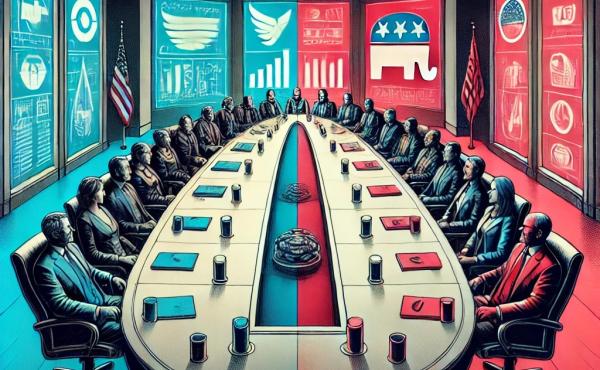
The ECGI blog is kindly supported by

Board behavioral dynamics: Between collaboration and control
The Board of Directors and the Top Management Team (TMT) together steer organizations and their activities. Scholars have debated the specific role and functions of boards (e.g., Boivie et al., 2022; Yakasai, Ormazabal, & Canals., 2022), the mechanisms by which board decisions shape the organization (e.g., Canals, 2022), as well as structural characteristics of boards (e.g., Almandoz & Tilcsik, 2016), amongst others. Following and increased societal interest in enhancing board effectiveness, governance researchers have focused on the so-called ´internal operations´ of the board (Cheng et al., 2021). Board internal operations capture the intragroup behavioral dynamics that characterize the board´s work processes (Cheng et al., 2021; Murphy & McIntyre, 2007) and give insight into how boards come to decisions. Yet, because of the field´s traditional focus on archival methods and the difficulty of getting high-quality data on these types of processes, insight in this domain is still limited (cf. Bjørnali et al., 2024; Westphal & Zajac, 2013).
The adjacent field of research on TMTs has focused on the internal operations of TMTs, and has empirically demonstrated the relevance of TMT behavioral dynamics, including decision making, conflict, and behavioral integration (Hambrick, 2007; Simons & Peterson, 2000), for organizational outcomes. TMT researchers have studied multiple aspects of the social and interpersonal processes of the TMT, and Organizational Behavior researchers studying non-managerial teams have developed even more detailed classifications (e.g., LePine et al., 2008). Less insight exists into the role of the board´s interpersonal processes. This is surprising, as board members -just as TMTs and other types of teams- need to find an optimal way to combine their members´ individual expertise and perspectives into outcomes and decisions for the collective (Almandoz & Tilcsik, 2023; Krause, Withers, & Waller, 2024). Moreover, given the idiosyncratic nature of the work of a board of directors, we should not assume that existing knowledge on either TMTs or non-managerial teams directly transfers to boards of directors (LePine et al., 2008; Westphal, 1999; Westphal & Zajac, 2013).
To study behavioral dynamics in decision-making groups, researchers generally point to task- and relationship focused aspects of people's interaction and collaboration (De Dreu & Weingart, 2003). Task processes describe the cognitive, verbal, and behavioral acts that describe a group´s taskwork, including cognitive conflict, debate and dissent (De Dreu & Weingart, 2003; Krause et al., 2024a; Veltrop et al., 2021). In contrast, relationship processes describe the affective, verbal and behavioral acts that relate to group members relationships while working on their tasks (Amason, 1996; Edmondson & McLain Smith, 2006; Jehn, 1995). In general, it is widely accepted that communication contains both task and relational oriented aspects, and that both aspects of the process will need to be effectively managed to achieve optimal outcomes (Burke et al., 2006). Therefore, an assessment of board behavioral dynamics should contain both task and relational aspects of the group´s process.
A key task-related process was developed by Hambrick, who coined the construct of behavioral integration to provide an assessment of the extent to which TMTs are effective in capturing the value that comes from the different perspectives that people bring to a decision-making group (Hambrick, 1994, 1995). Specifically, TMT behavioral integration, or ‘teamness’, describes the extent to which TMT members make joint decisions, share information and opinions openly and work collaboratively (Hambrick, 1995; Raes et al., 2013; Simsek et al., 2005). Research has shown that TMT behavioral integration is beneficial for numerous strategic- and performance-related outcomes, including strategic decision quality, economic performance and human resource performance (e.g. Carmeli, 2008; Carmeli and Halevi, 2009; Carmeli and Schaubroeck, 2006; Li and Hambrick, 2005; Ling et al., 2008; Lubatkin et al., 2006).
TMTs with a higher level of teamness see the value of the complementarities and integration of each member’s skills and knowledge, which makes them more effective in making and implementing strategic decisions as compared to TMTs with a lower degree of teamness (Carmeli, 2008; Ling et al., 2008). As such, it provides a comprehensive assessment of whether a group of executives resembles more a ´real team´ or rather a ´set of semi-autonomous barons´ (Hambrick, 1995). While primarily documented for TMTs, a recent paper assessed the behavioral integration of boards in the context of high-tech start-ups (Bjørnali et al., 2024). These authors used a 5-item board behavioral integration scale, and demonstrated the role of informal communication frequency, intra-board trust, and efficacious board chair leadership as factors that contribute to intra-board behavioral integration. While Bjornali and colleagues (2024) did not assess the impact of board behavioral integration on outcomes, the demonstrated benefits of TMT behavioral integration may be a promising starting point for a behavioral approach to board decision-making.
All in all, I argue for using the knowledge from TMT interpersonal dynamics, and particularly the concept of teamness to enhance understanding of board interpersonal dynamics, and the way in which those interpersonal dynamics relate to the outcomes of the board´s work, such as their decisions and organizational impact. This is ultimately of interest not only to researchers, but particularly also for board members who seek to enhance their value to their organizations.
-------------------------------
By Anneloes Raes, IESE Business School
The ECGI does not, consistent with its constitutional purpose, have a view or opinion. If you wish to respond to this article, you can submit a blog article or 'letter to the editor' by clicking here.




